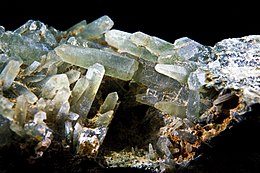Prasiolite
| Prasiolite | |
|---|---|
 | |
| General | |
| Category | Oxide mineral |
| Crystal system | Trigonal |
| Identification | |
| Color | Shades of green |
| Crystal habit | Hexagonal prisms |
| Cleavage | None |
| Fracture | Conchoidal[1] |
| Tenacity | Brittle[1] |
| Mohs scalehardness | 7 – lower in impure varieties[1] |
| Diaphaneity | Transparent to nearly opaque |
| Specific gravity | 2.65 |
| Refractive index | 1.544 to 1.553[2] |
| Birefringence | 0.009[3] |
| Ultravioletfluorescence | None |
Prasiolite(also known asgreen quartz, green amethystorvermarine) is agreenvariety ofquartz.
Since 1950, almost all natural prasiolite has come from a smallBrazilianmine,[citation needed]but it has also been mined in theLower Silesiaregion ofPoland.Naturally occurring prasiolite has also been found in theThunder Bayarea ofCanada.[4]
Most prasiolite sold is used injewellerysettings, where it can substitute for far more expensive preciousgemstones.
Prasiolite is a rare stone in nature; artificial prasiolite is produced by heat treatment ofamethyst.[4]Most amethyst will turn yellow or orange when heated, producing heat-treated amethysts which are often marketed ascitrine,but some amethyst will turn green when treated. Currently, almost all prasiolite on the market results from a combination of heat treatment andionizing radiation.[5]
Green quartz is sometimes incorrectly called green amethyst,[6]which is not an acceptable name for the material according toFederal Trade CommissionGuidelines. Other names for green quartz include vermarine and lime citrine.[7]
The word prasiolite literally means "scalliongreen-colored stone "and is derived fromGreekπράσονprasonmeaning "leek"and λίθοςlithosmeaning "stone". Themineralwas given its name due to its green-colored appearance.
Natural prasiolite is a very light, translucent green. Darker green quartz is generally the result of artificial treatment.[8]
See also[edit]
References[edit]
- ^abc"Prasiolite gemstone information".www.gemdat.org.Retrieved19 April2018.
- ^Lazarelli.Blue Chart Gem Identification.p. 7.
- ^"PRASIOLITE the green variety of quartz (aka Green Amethyst)".www.galleries.com.Retrieved19 April2018.
- ^ab"Prasiolite".quarzpage.de. 28 October 2009.Retrieved28 November2010.
- ^"Mineral Spectroscopy Server".California Institute of Technology. 11 June 2012.Retrieved10 December2012.
- ^"Green Amethyst".GemSelect.Retrieved10 December2012.
- ^"Green Quartz Meaning and Properties".firemountaingems.com.n.d.Retrieved21 October2021.
- ^Gems and Gemstones: Timeless Natural Beauty of the Mineral World By Lance Grande, Allison Augustyn, p.91
External links[edit]
